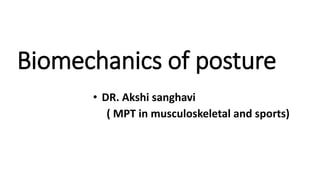This document provides an overview of posture biomechanics, including:
1. Definitions of static and dynamic posture, and descriptions of optimal sagittal and frontal plane alignment.
2. Explanations of how posture is controlled through sensory inputs, muscle activity, and strategies like fixed support and changing support.
3. Analyses of deviations from optimal posture, including positions of the foot, knee, spine, and effects of sitting and lying postures. Factors like age, gender, and occupation are also discussed.






















































